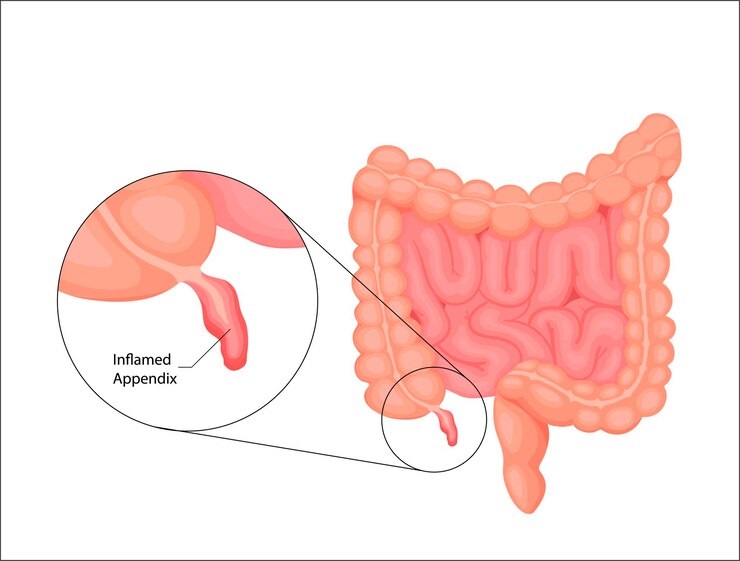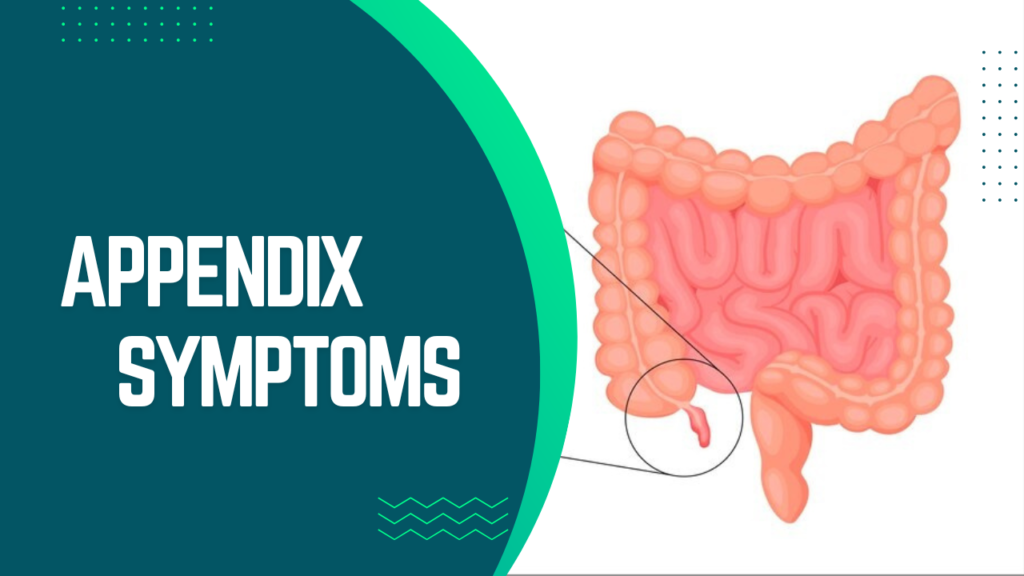The appendix, a small organ situated in the lower right abdomen, often goes unnoticed until it becomes the source of discomfort. Understanding the symptoms associated with appendix issues is crucial for prompt intervention. In this article, we’ll explore the common signs, causes, and treatment options for appendix-related problems.
Normal Function of the Appendix
The appendix takes on the form of a finger-shaped pouch, linking itself to the large intestine. While its exact function remains unclear, it is generally considered vestigial, suggesting it served a purpose in our evolutionary past. Today, the appendix is not essential for digestion, and its removal does not typically impact overall health.
Common Symptoms of Appendix Issues
Abdominal pain and tenderness
The hallmark symptom of appendix problems is pain, usually starting near the navel and later moving to the lower right abdomen. Tenderness in this area is often a cause for concern.
Nausea and vomiting
Appendix issues can cause nausea and vomiting, especially if the pain becomes severe. Continued vomiting could be a sign of a more severe underlying health issue.
Loss of appetite
A sudden loss of appetite, coupled with abdominal discomfort, can be indicative of appendix problems. Be mindful of alterations in dietary patterns.
Elevated temperature
A mild fever may accompany appendix symptoms, reflecting the body’s response to infection or inflammation.

Appendicitis: A Closer Look
Appendicitis is the inflammation of the appendix, often resulting from a blockage. If left untreated, it can lead to a burst appendix, a serious and potentially life-threatening condition.
Definition and causes
Appendicitis occurs when the appendix becomes blocked, usually by stool, a foreign body, or, in some cases, a tumor. The obstruction prompts the proliferation of bacteria and the onset of inflammation.
Rapid progression of symptoms
Appendicitis symptoms can progress rapidly. What starts as mild discomfort can escalate to severe pain within a matter of hours. Immediate medical attention is crucial.

Atypical Symptoms to Watch For
Discomfort around the navel
At the onset of appendix issues, some individuals may experience discomfort around the navel before the pain shifts to the lower right abdomen. Recognizing this early sign is vital.
Changes in bowel habits
Appendix problems can cause changes in bowel habits, such as diarrhea or constipation. Any unexplained shifts should be discussed with a healthcare professional.
Low-grade fever
Even a mild increase in body temperature can be a sign of appendix issues. Monitoring for persistent low-grade fever is essential.

Diagnosing Appendix Symptoms
Diagnosing appendix problems involves a combination of physical examination, imaging tests, and blood work.
Physical examination
Healthcare providers may perform a physical examination, checking for tenderness in the lower right abdomen and other signs of appendicitis.
Imaging tests: CT scans and ultrasounds
Imaging tests, such as CT scans and ultrasounds, can provide detailed images of the appendix, aiding in the diagnosis.
Blood tests to check for infection
Elevated white blood cell counts in blood tests can indicate an infection, supporting the diagnosis of appendix issues.

Immediate Steps if You Suspect Appendix Issues
If you suspect appendix problems, seeking emergency medical attention is crucial.
Seeking emergency medical attention
Appendicitis requires prompt treatment, usually involving surgical removal of the appendix. Procrastination in seeking assistance can result in the development of severe complications.
Avoiding self-diagnosis and self-treatment
Self-diagnosis and attempts at self-treatment can be risky. Only a healthcare professional can accurately diagnose and treat appendix issues.

Treatment Options for Appendix Conditions
Treatment for appendix problems typically involves surgical removal of the appendix.
Surgical removal (appendectomy)
An appendectomy is a common surgical procedure to remove the inflamed appendix. The procedure can be conducted through conventional open surgery or the use of minimally invasive laparoscopic techniques.
Antibiotics for less severe cases
In some cases, particularly if the appendix has not burst, antibiotics may be prescribed to treat the infection.
Recovery and postoperative care
Recovery after an appendectomy is usually swift. Following postoperative care instructions is essential for a smooth recovery.

Complications of Untreated Appendix Issues
If left untreated, appendix issues can lead to serious complications.
Perforation and infection
A burst appendix can result in the release of infectious material into the abdominal cavity, leading to peritonitis.
Peritonitis and its consequences
Peritonitis involves the inflammation of the peritoneum, the protective lining within the abdominal cavity. It is a severe and potentially life-threatening complication of a burst appendix.

Preventing Appendix Problems
There are no specific preventive measures for appendix issues, but early detection and prompt treatment are crucial.
No specific preventive measures
As the exact cause of most cases of appendicitis is unclear, specific preventive measures are challenging to identify.
Importance of early detection and prompt treatment
Recognizing symptoms early and seeking immediate medical attention are key to preventing complications associated with appendix issues.
Living Without an Appendix
Dispelling myths about life after appendectomy is essential for individuals undergoing the procedure.
Dispelling myths about life after appendectomy
Life without an appendix is generally normal, with no significant impact on overall health. Dietary and lifestyle adjustments are usually minimal.
Adjustments and impact on digestive health
While the appendix is not vital for digestion, some individuals may experience minor adjustments in bowel habits post-appendectomy.
Myths and Facts about Appendix Symptoms
Addressing common misconceptions about appendix symptoms is crucial for accurate understanding.
Addressing common misconceptions
Dispelling myths, such as the belief that appendix issues only occur in specific age groups, promotes accurate information.
Providing accurate information
Educating individuals about the signs, causes, and treatment options for appendix symptoms helps combat misinformation.
Appendix Symptoms in Different Age Groups
Symptoms of appendix issues can vary based on age, influencing diagnostic approaches.
Variances in symptoms based on age
Understanding age-related variations in appendix symptoms guides healthcare providers in tailoring diagnostic strategies.
Tailoring diagnostic approaches
Adapting diagnostic approaches based on age ensures a more accurate assessment of appendix symptoms.

Appendix Symptoms in Children
Appendix symptoms in children may present differently, requiring unique considerations.
Unique considerations for pediatric cases
Children may struggle to articulate their symptoms, making keen observation by parents and healthcare professionals crucial.
Signs parents should watch for
Parents should watch for changes in behavior, eating habits, and abdominal discomfort in children, seeking medical attention if any concerns arise.
Conclusion
In conclusion, recognizing and understanding appendix symptoms is vital for timely intervention and effective treatment. Whether it’s abdominal pain, changes in bowel habits, or other distress signals, seeking medical attention promptly can make a significant difference in outcomes.

FAQs
In most cases, surgical removal is necessary. Delaying treatment can lead to complications, such as a burst appendix.
Appendix issues can occur at any age, with symptoms varying. Age-related factors may influence diagnostic approaches.
Antibiotics may be prescribed for less severe cases, but surgical removal is the primary treatment for appendicitis.
Generally, no specific dietary restrictions are necessary post-appendectomy. Individuals can resume their normal diet.
Yes, the appendix is not essential for overall health. Individuals typically lead normal lives after appendectomy.







